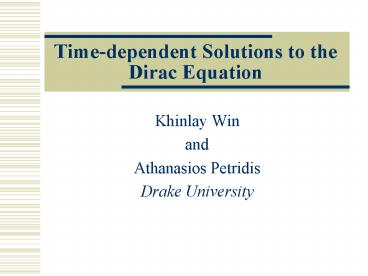Timedependent Solutions to the Dirac Equation - PowerPoint PPT Presentation
1 / 20
Title:
Timedependent Solutions to the Dirac Equation
Description:
Relativistic quantum equation for spin-1/2 fermions, which ... These results are in agreement with J. W. Braun, Q. Su, and R. Grobe, Phys. Rev. A59, 604 (1999) ... – PowerPoint PPT presentation
Number of Views:74
Avg rating:3.0/5.0
Title: Timedependent Solutions to the Dirac Equation
1
Time-dependent Solutions to the Dirac Equation
- Khinlay Win
- and
- Athanasios Petridis
- Drake University
2
The Dirac Equation
- Relativistic quantum equation for spin-1/2
fermions, which are described by a 4-dimentional
spinor ?. - In the presence of an external scalar potential,
V
3
The Numerical Algorithm
- The staggered leap-frog algorithm is applied in a
spatial grid of bin-size ?x (in 1 dimension) and
with time step ?t - The spatial derivatives are computed
symmetrically. - Reflecting boundary conditions are applied on a
very large grid (running stops before reflections
occur).
4
Free Electron Propagation
- The initial spinor is (N normalization factor,
m 1) - The probability density ??? at t0 is Gaussian
(s.d.s0). - As s0?8,? becomes a positive energy plane wave,
which for p0 is a spin 1/2 eigenstate. - ?(x,t) is shown in Figure 1 for s01. The method
is stable. The accuracy is of order 10-10 per bin
(?x0.01, ?t0.001).
5
Time unit 1/m 1.0
Figure 1.
6
Position Expectation Value
- Figure 2 ltxgt vs time after subtraction of the
drift velocity (red s0 0.5, p 0.01 green
s0 0.5, p1.37 blue s01, p0.01, purple s0
1.5, p1.0). - High-frequency (2E) oscillations are observed
(Zitterbewengung). - The effect has a non-linear dependence on s0 and
is maximized when 2 s0 ?c (Compton wavelength)
for given p. It increases with p.
7
Figure 2.
8
Standard Deviation
- In Figure 3 the standard deviation of the
probability density, s, is shown vs time (red s0
0.5, p 0 green s0 0.5, p1.0 blue s0
1.0, p 0 purple s0 1.0, p 1.0 light
blue s0 1.5, p 0 yellow s0 1.5, p
1.0). - High-frequency oscillations are observed. They
are more pronounced as p increases and die out
with time. - The wave-packet spreads faster at lower p.
9
Figure 3.
10
Spin, z-component
- In Figure 4, the expectation value of the
z-component of the spin (perpendicular to the
propagation direction) is shown (red s0 0.5, p
0.01 green s0 0.5, p 1.37 blue s0
1.0, p 0.01 purple s0 4.0, p 0.0). - The observed high-frequency oscillations die out
with time and are maximized at 2 s0 ?c. - These results are in agreement with J. W. Braun,
Q. Su, and R. Grobe, Phys. Rev. A59, 604 (1999).
11
Figure 4.
12
Decay and Survival Probability
- A decaying fermionic system can be described as a
Dirac spinor initially set inside a potential
well that tunnels through the potential walls. - In a given reference frame, the survival
probability of the system is defined as
13
Finite Square Well Potential
- The strength, V, is varied and the width, 2a, is
set equal to 2 s0 with s0 ?c 1.0. - Pin vs time is shown in Figure 5a (p 0) for V
0.1 (red), 1.0 (green), 1.5 (blue), and 2.0
(purple) and Figure 5b for V 0.1, p 0.01
(red), V 2.2, p 0.01 (green), V 0.9, p
0.1 (blue) and V 2.2, p 0.1 (purple). - Pin decays non-exponentially performing
oscillations. This has also been observed in
non-relativistic decays. It is due to reflections
on the walls. - The relativistic case, however, includes a sudden
increase in Pin for V gt 1 due to
particle-antiparticle creation (Klein-paradox)
that slows the decay down. The effect of p is
small.
14
Figure 5a.
15
Figure 5b.
16
Finite Quadratic Potential
- Harmonic oscillator potential a4x2/2, cut at x
s0 1.0. - In Figures 6a and b Pin is shown vs time for a
0.5, 2.5, and 3 (red, green, blue in 6a) and a
3.2, 3.6, and 4 (red, green, blue in 6b). - Oscillations (often irregular ones) are observed
as before. - As a increases the decay initially becomes faster
due to pair production at the edges of the well
off-resonance decay. - As a becomes large the initial spinor approaches
a resonance state of the potential (near the
ground state of the harmonic oscillator). After
some initial oscillations Pin is nearly
exponential in time (for medium t)
near-resonance decay.
17
Figure 6a.
18
Figure 6b.
19
Conclusions
- The staggered leap-frog algorithm is stable and
accurate, providing solutions to the
time-dependent Dirac equation. - Results are obtained in a few minutes on an
average personal computer. - Zitterbewengung is observed in the expectation
value and standard deviation of the position and
the expectation value of the spin, depending on
the initial width of the spinor relative to the
Compton wavelength and the central momentum. - Spinors initially set in a potential well decay
in an non-exponential manner exhibiting
oscillations. Nearly exponential decay is
observed near-resonances.
20
Perspectives
- Three-dimensional problems can be addressed using
this method. - Electromagnetic 4-potential interactions can be
inserted (external and/or internal). - Relativistic decays of mesons to leptons can be
studied in free space and in medium (the
oscillations change the effective interactions
with the medium). - Relativistic spin-wave propagation can be
explored.































